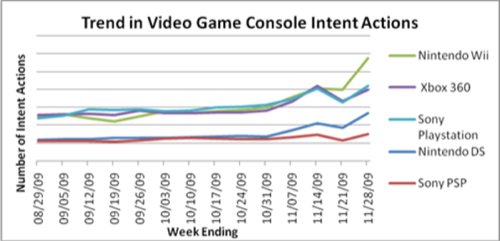BlueKai is an online marketing firm that provides data to marketers, ad networks and publishers. The main purpose of this data, held in a repository called the BlueKai Data Exchange, is to target ads to consumers. BlueKai claims to have now aggregated “intent data” from over 160 million unique users on e-commerce, online travel agency and auto comparison sites.

What is “intent data”? Broadly speaking, it’s data that purports to show the intent of Web users when they browse a website. For example, a recent report from BlueKai collected and analyzed online shopping data over Black Friday week. In this post we look at that report’s findings and then ask some questions about the validity of the data.
Black Friday Online Shopping: Netbooks & Nintendo Popular
BlueKai defined the resulting “shopping intent” data as “search and shopping related activities by consumers on retail and price comparison sites.” Specifically these “intents” included price search by auto make and model, travel destination search by airport or city, and activity on price comparison sites.
The report analyzed “more than 10 million online shopping intent actions” for PCs and video game consoles through the week ending November 28, 2009.
Here’s a chart showing that netbooks, rather than the recently released Windows 7, had the biggest increase in shopping intent actions in the PC category over the Black Friday holiday period.

BlueKai explained:
“Online intent actions by those shopping for Netbooks surged 81% during the week of Black Friday versus the prior week, with Netbooks reaching 7.1% share of total PC online intent actions for the week ending November 28. Just a month prior, Netbooks comprised only 2.7% of PC-related online intent actions on the BlueKai Exchange.”
Here’s another chart, this time showing that Nintendo game devices, and in particular the Wii, held the most interest amongst online shoppers during Black Friday week.

How it Works
A New York Times article earlier this year profiled both BlueKai and a similar data house called eXelate. The Times explained how they work:
“They both track who is interested in what through a cookie, an invisible bit of code on a Web page. When someone does a search, for example, on Kayak.com for first-class flights to Paris in September, that information can be captured by a cookie, and Kayak.com can sell that cookie using eXelate or BlueKai.”
As well as intent data, BlueKai recently announced a new service that gives advertisers access to shopper profiles. BlueKai CEO Omar Tawakol claimed that this gives advertisers insight into “actual shopping patterns,” as opposed to merely surveying a user base.
The problem is, BlueKai is inferring things about a consumer that may not be true. Claire Herminjard of the now defunct Lookery, which tried (and failed) to make a business of capturing explicit user data via a piece of javascript in partner sites, put it well: “[we] make no assumptions about users. If we don’t have data on a consumer, we don’t pretend that we do (or assume what we think it may be).”
Although Herminjard was primarily trying to position Lookery as a better data source, her other point was that BlueKai is essentially a “black box” and its data can’t be substantiated when it comes to users – or their intents.
Questions Over Data Reliability, But There’s a Big Market For It
What BlueKai is doing is similar to the methods used by the raft of recommendation engines we’ve profiledthis year. We found in that series that each recommendation engine had its own methods and algorithms; and that it was difficult to judge the accuracy of the data and which company’s method worked best.
Likewise, I’m somewhat skeptical of BlueKai’s data claims, especially given how unreliable web data usually is (Alexa anyone?).
Nevertheless, BlueKai is attempting to mine a large store of data that up till now has been very difficult to gather and analyze on a large scale online: user patterns on commerce sites. Whether or not the data is reliable is an open question for now, but there is a large market for it – and that will continue as long as online advertising is the main business model on the Web.

















